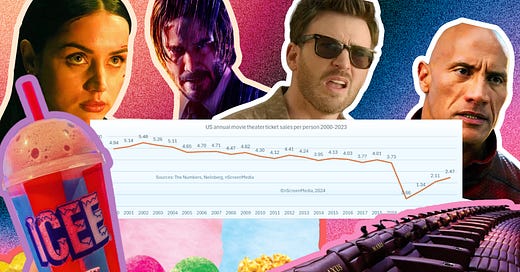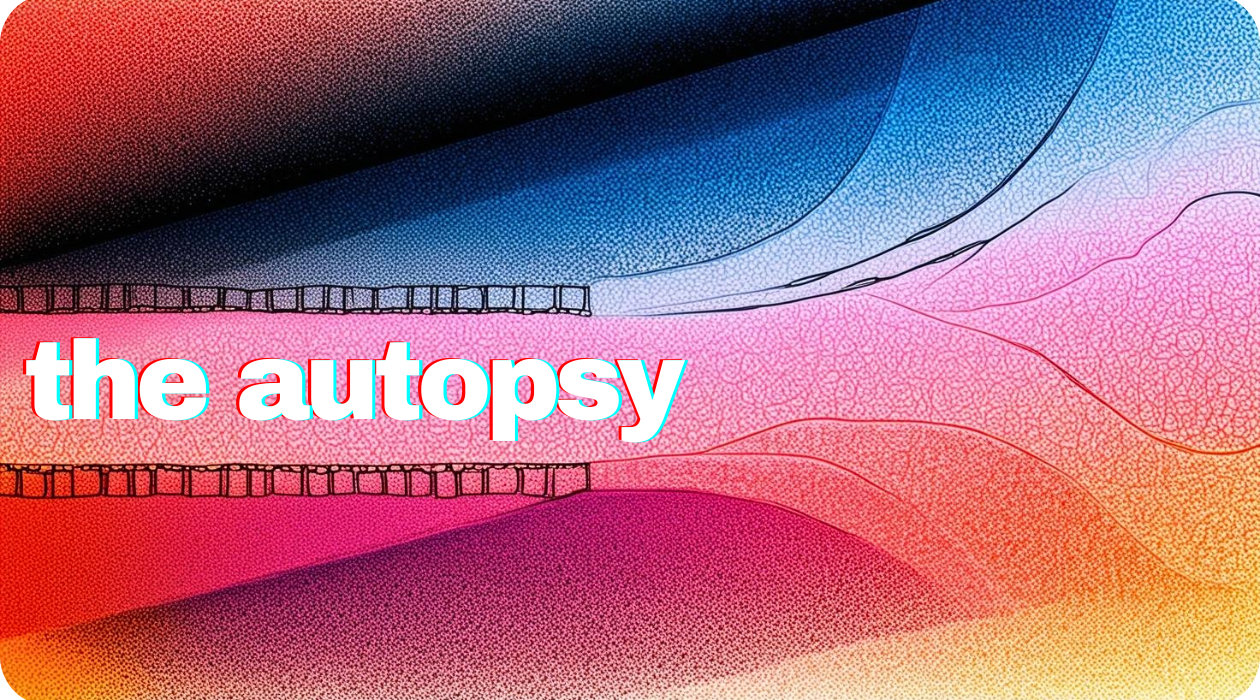the death of cinema & how to bring it back to life (part 1)
I paid £20 to watch someone scroll through pasta recipes during a r*pe scene, and that's not even the worst part of going to theaters in 2025.
My dad took me to see Monsters, Inc. on opening weekend when I was nine. He bought tickets three days in advance, and we still had to wait in a line that wrapped around the multiplex twice. The guy behind us also came with his daughter and wore a homemade Sullivan costume with face paint melting in the May heat. A teenage couple passed a Monsters Inc. sticker book back and forth, placing holographic door stickers on each page while debating which monster would make the best roommate. Nobody checked their phones because it was 2001 and the most advanced thing we carried was a Tamagotchi that had probably died of neglect somewhere in my pocket.
Flash forward to two months ago: I'm watching The Brutalist in a half-empty theater, and the woman next to me is scrolling through TikTok recipes during the entire you-know-what sequence. Not even IMAX-amplified sexual violence could compete with a 15-second video of someone making air fryer pasta.
This isn't just another "phones bad, remember when movies were good" rant. Promise.
After 8+ years of helping brands figure out why people do what they do (and how to get them to do something else), I've learned that telling people they're wrong, lazy, or stupid for their choices is the fastest way to ensure they switch sidewalks when they see you. It’s silly and ineffective. So instead of the usual film bro lament about audiences who don't appreciate "real cinema," I want to explore why even people who love movies aren't showing up to theaters1 anymore.
The numbers tell a surface story that you've probably heard before: 25% of moviegoers attend the cinema at least every other month, compared with 40% pre-pandemic. The first quarter of 2025 saw a 7% decline in US and Canada box office revenue compared to the same period in 2024 (with March down by 50% year-over-year). One in ten UK cinemas2 faces closure due to declining attendance and rising operational costs.
If you're still reading this, you already know the cinema industry is in trouble.
What those numbers don't tell you is what's actually been lost—a ritual that was as much about preparation, anticipation, and community as it was about the movies themselves. My grandmother used to talk about "picture day" in 1950s Crete—hair done, stockings on, maybe splurging on a malt afterward if the feature was good. You bought the ticket, but the social contract included dress codes, behavioral expectations, and temporal commitment.
So I spent months digging through behavioral psychology studies, reading theater owner interviews, and looking at my notes from my film marketing days to understand what the hell is happening to our cinema culture.
The result is a sprawling three-part series that I’ll be rolling out over the next few weeks (I kick off with Part I in this edition):
Part 1: THE AUTOPSY aka the major systemic factors strangling theatrical cinema—all the problems keeping butts out of seats
Part 2: THE EXCAVATION aka the underlying psychological factors keeping us all at home
Part 3: THE RESURRECTION aka concrete pathways to give theaters the kiss of life they desperately need
So grab your overpriced popcorn and silence your phones. The feature presentation is about to begin.
Cinema's cultural demotion came through many interconnected system failures occurring simultaneously but mainly: the exhibition space lost its magic, the distribution model cannibalized itself, and marketing became culturally irrelevant.
THE EXHIBITION SPACE HAS LOST DISTINCTION BY DESIGN
The physical theater experience died with a whimper, not a bang. Founding Director The Big Picture, John Sullivan, confirms what we've all been feeling—multiplexes now function like human conveyor belts, shuttling us in and out. Remember hanging in the lobby, debating whether the ending made sense, or whether that was actually Willem Dafoe in a background scene? Gone.
Cinema consultant Rob Arthur points out the spectacular irony: audiences actually want to linger and socialize (and eat something better than stale nachos with radioactive cheese), but theaters are too busy installing express lanes and ordering apps to notice. They've literally designed away the magic—the "wow factor" that made theaters feel like destinations rather than sad, sticky pit stops between errands.
Even the physical spaces tell the story. Everything's designed to get you in and out as efficiently as possible, like you're at a Subway rather than a cultural institution. We traded distinctive architecture for corporate uniformity that feels like walking into an airport Marriott. The saddest part is that while theaters were abandoning their potential as "third places", other industries were discovering just how valuable that role could be. Bookstores added cafés. Coffee shops became remote offices. Libraries transformed into community hubs. And what do theaters have to show for it? Installed mobile ordering so you don’t have to interact with a single human being on your way to your isolated luxury recliner.
On top of this, exhibition executives responded to declining attendance with a strategy that shows just how disconnected they've become from their audience. AMC invested over $600M in renovations for luxury seating—which did boost attendance at renovated locations—but also reduced capacity by 64% per theater. Meanwhile, ticket prices steadily climbed: US averages went from $9.11 in 2019 to $12.22 in 2024, Australia saw a 17% jump3, and Canada's premium screenings now regularly exceed $16 CAD.
I paid nearly £20 for a regular showing at Leicester Square in London last month. Around £10 for popcorn with a side of Coke. About £7 on the tube to get there and back. For a family of four, that's weekly grocery money gone. And it's not just the ticket—it's gas, parking, childcare, and the £5 small soda that make regular attendance impossible during a cost-of-living crisis. Tarantino has been saying this very thing since 2016: movie tickets have priced out the working class—the very people who once made up cinema's backbone.
And somewhere in this mad dash to luxury, the industry completely lost touch with Gen Z. Fandago data shows while most moviegoers still cite "escape" as their reason for going to theaters, young audiences are after something else entirely: social connection. They want to be together, to laugh and gasp and process in real time with friends. I often notice group of teens fully invested—reactions, side comments, the whole thing. It’s easy to pass this off as rudeness, but what I’m witnessing is desperation.
After years of being told they're phone-addicted zombies with no attention spans, young people still want to experience stories together, and we've built a system that subtly punishes them for it. It's not that talking through movies is great (it's not), but there's a weird disconnect happening—we've created the perfect cinema experience for middle-aged couples on date night and completely abandoned another key demographic that has historically kept theaters alive.
The cinema experience, my dear reader — brace yourself for this, fails at every level of Maslov’s hierarchy of needs. A study found that an average of 1,864 colonies of bacteria exist on a single cinema seat—14 times the number of germs typically found on a toilet seat. Beautiful! Self-actualization isn’t happening either. The supposed ultimate cinema experience, that magical immersion that cinemas claim we can’t get anywhere else, isn’t selling. Sixty-one percent of moviegoers now believe streaming gives them the same thing, according to Fandango.
No wonder people opt in for their couch.
THE DISTRIBUTION MODEL ATE ITSELF ALIVE
The collapse of the theatrical window represents one of the most consequential shifts in cinema history. Theatrical exclusivity periods shrank from 90+ days to an average of 32 days for major studio releases in 2024. Some films are ditching the theater after a mere 17 days, like a one-night stand that ghosts you before breakfast. And why wouldn't they? Studios keep about 80% of that sweet PVoD revenue compared to the 55% table scraps they get from theatrical.

The window collapse came with devastating second-order effects. The share of frequent moviegoers (the monthly-or-more crowd) fell from 11% in 2019 to 6% in 2024, while BFI reports 44% of UK audiences are willing to wait for films to become available on streaming services rather than watching them in cinemas. The cultural expectation shifted from "see it now" to "catch it eventually" for everything except franchise tentpoles with spoiler concerns. Why have cultural necessity when you can have optional luxury?
Studios have stopped pretending theatrical runs are anything but extended marketing campaigns for streaming platforms. For example, Amazon Studios has stated that the theatrical release of Red One was undertaken to ensure its streaming success. Despite earning $80 million at the box office (half going to theater owners), Amazon considered it a success because it drove significant engagement on Prime Video, where it became the platform's top movie with 50 million viewers within four days of its streaming debut. Theatrical releases is now seen as awareness generation for streaming, which is another way of saying "we're using theaters as billboards now."
The casualties? Every movie that isn't a spoiler-heavy franchise blockbuster. Adult dramas and comedies are the endangered species in this new ecosystem. When everyone knows your mid-budget film will be streaming in 32 days, the urgency evaporates. Why spend $15 on a ticket when patience costs nothing?
Over 90% of independent and mid-budget films never even get the chance to flicker on a theater screen, instead going straight to streaming purgatory. Romantic comedies, on the other hand, have practically vacated theaters, relegated to Netflix's algorithmic wasteland where they're cheaper to make and market.
We're trapped in a self-fulfilling prophecy of the worst kind. Whenever a mid-budget film underperforms, studios nod sagely and say, "See? Nobody wants these anymore." But when a $300 million superhero movie face-plants, it's just a temporary setback before the next franchise instalment rights the ship. The cognitive dissonance is staggering—failure for adult films is definitive proof the genre is dead, while failure for tentpoles is merely a blip to be absorbed by the larger franchise machine.
It's simple economics dressed up as cultural shift. When marketing a theatrical release costs more than making the actual movie, studios make the obvious choice: either go massive with guaranteed global appeal or go cheap and skip theaters entirely.
The real knife-twist, however, is what it's done to our habits. Behavioral psychology tells us we need reinforcement at least every 41 days to form a habit. The shortened window ensures that by the time you consider going back to theaters, whatever you wanted to see is already available at home with the added bonus of pausing for bathroom breaks. Try forming a gym habit where the equipment teleports to your living room after three weeks. Why even bother putting on pants?
THE MARKETING HAS STAYED FROZEN IN AMBER
I quit my film marketing job after presenting a creative strategy to a studio that the head of PR called "too experimental" despite tons of research poured into it. That same week, they greenlit a $140 million campaign centered on...TV spots and bus wraps. This was 2019.
Movie marketing is trapped in the era of Friends and Seinfeld—still pursuing mass awareness through mass media when attention has splintered into a thousand niches. Studios spend obscene amounts on the exact same promotional field guide: trailer drop, press junkets, billboards, TV spots and some social ads here and there. Hundreds of millions spent to generate awareness without urgency or cultural relevance.
Netflix transformed Formula 1 into American water-cooler discussion through Drive to Survive—a sport previously invisible to most Americans. They repeated this with tennis players in Break Point, cyclists in Tour de France: Unchained, and chefs in various cooking competitions. The approach wasn't simply documentary storytelling but creating entire cultural ecosystems around these subjects—podcasts, merchandise, social media communities, and in-person events that turned content consumption into cultural participation.
 Tiktok failed to load.
Tiktok failed to load.Enable 3rd party cookies or use another browser
Despite all this, actor interviews continue to shrink while pre-approved question lists expand (I talk more about this phenomenon here). The typical press junket now involves journalists getting approximately seven minutes with an actor who's been trained to say nothing interesting while pretending they're having fun.
THE RELEASE CALENDAR HAS PLAYED FEAST-OR-FAMINE
You know when your favorite restaurant is open consistently? Now imagine if they were only open on 12 random weekends a year, and the rest of the time you had to stare through the windows at an empty dining room with staff standing around.
The movie industry has created a feast-or-famine schedule that actively destroys any chance of building consistent audience habits. We recently watched a holiday traffic jam with Wicked, Moana 2, Mufasa, and Sonic 3 all throwing elbows for the same family dollars. Then January arrived and theaters might as well have put up "Gone Fishing" signs until May. Nothing says "sustainable business model" like concentrated overload followed by months of tumbleweeds.
The scheduling decisions read like they were made by pulling random dates from a hat. Who thought putting Lilo & Stitch and How to Train Your Dragon within weeks of each other was smart? Why waste prime spring break weeks on untested titles like Love Hurts when audiences are actually looking for something to watch? Why sacrifice Ballerina to the summer bloodbath when spring is sitting there, empty and available?
Every other entertainment business understands that consistency builds habits. TV networks maintain regular programming to keep viewers coming back. Sports leagues space their games throughout a season to sustain fan engagement. Local music venues balance their calendars for steady attendance. But film distribution has transformed theaters from weekly entertainment options into occasional destinations for special events.
When March 2025 shows a weekend gross of just $69 million compared to $167 million during February's Presidents' Day weekend, that's not random consumer behavior. That's the direct result of programming strategy. What makes this particularly frustrating is that the solution isn't complicated. Don't make audiences choose between three movies they want to see in one weekend, then give them nothing for months.
The industry keeps talking about the theatrical experience as something special and unique. But they're the ones who made it special and unique by making it rare and inconsistent. If they want audiences back in theaters year-round, they need to give us reasons to be there year-round. Not just when Greta Gerwig and Christopher Nolan happen to release movies on the same weekend.
The physical 'upgrades' that sucked the life out of theaters, the self-devouring distribution models, the endless parade of franchise-tentpole clones, the marketing stuck in the past—and, crucially, the cultural conversation that abandoned cinemas entirely—all these failures, are interconnected. They are gears in a machine, one that turned cinema into something irrelevant.
My nine-year-old nephew recently asked what moviegoing was like "in the old days” (lol 👵). I started to explain the atmosphere of opening night – queuing with invested strangers, collective gasps, animated lobby debates afterward. I watched curiosity in his eyes fade to polite boredom.
"But why wouldn't you just watch it at home later?" he asked.
In 2025, I'm struggling to find a compelling answer. And that's the real problem: cinema's decline doesn’t merely have to do with failing business models or technological shifts. It's about something deeper in our psychological relationship with movies and each other.
To better understand why theaters are struggling, I had to look beyond the industry's systemic failures and into the minds of the audience itself.
Part II drops in the next couple of weeks, where I'll explore the psychological shifts happening beneath these industry failures. For anyone who thinks "they just need to make better movies," you might want to buckle up.
If this resonated, share it with film industry folks in your orbit. Sometimes it takes an outsider to say what insiders already know but can't admit.
And drop a comment – I want to hear which theaters you've seen actually getting it right, or what would make the theatrical experience worth defending again.
A final note for people with taste 🫦
While the internet's prioritizing hot takes and SEO-optimized nothingness, I’m here building a sanctuary for people who believe film and television criticism can be thoughtful, accessible and fun all at once.
For the price of a truly mediocre sandwich, consider joining the resistance with a paid subscription – it keeps independent film writing alive and the algorithms at bay.
Plus, you'll get exclusive access to After Credits, my monthly handpicked selection of films & tv shows that will stop you from doomscrolling Netflix AND exclusive access to my more personal posts.
Now go forth and raise those standards, darling.
- Sophie x
I interchangeably use theaters/cinemas in this series because I’m over-caffeinated and I’m a byproduct of modern Western mushy culture.
This series has drawn from English-speaking markets because this was the type of data I was able to find more readily available. In an ideal world, I would have loved to explore how these trends fare out across the globe (but these reports are really pricey!!).
These are 2023 numbers. I was not able to find more recent and readily available sources.








The way I grabbed a Diet Coke before sitting down to read this😂 I love your writing and you can tell it’s so well-researched. Looking forward to part two!!
This is one of the best things I’ve ever read on Substack. Brilliant stuff. Your opening also brought back a ton of childhood memories of ‘event cinema’ for me.